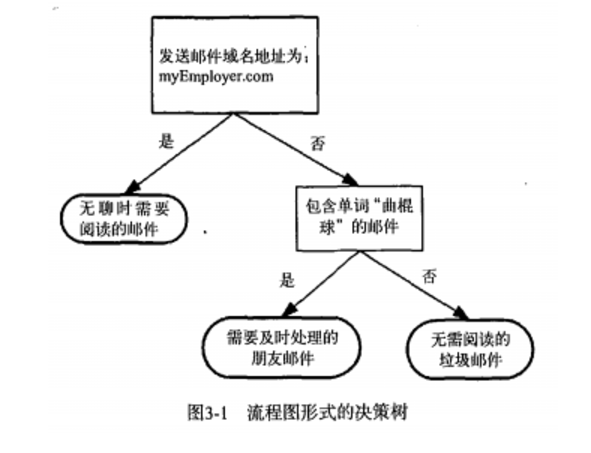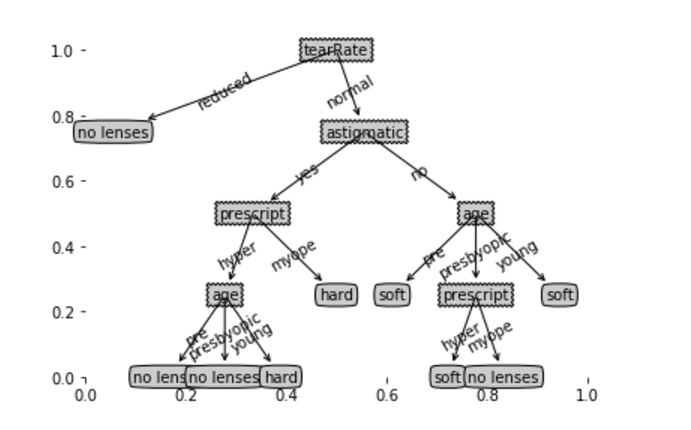

正方形代表判断模块(decision block) ,椭圆代表终止模块(terminating block),表示已经得到结论,可以终止运动。
决策树的优势在于数据形式容易理解。决策树的很多任务都是为了数据中所蕴含的知识信息。决策树可以使用不熟悉的数据集合,并从中提取出一系列规则,机器学习算法最终将使用这些机器从数据集中创造的规则。
3.1决策树的构造
优点:计算复杂度不高,输出结果易于理解,对中间值的缺失不敏感,可以处理不相关特征数据。
缺点:可能会产生过度匹配的问题。
适用数据类型:数值型和标称型。
1.先讨论数学上如何使用信息论划分数据集;
2.编写代码将理论应用到具体的数据集上;
3.编写代码构建决策树;
创建分支的伪代码函数createBranch()
检测数据集中的每个子项是否属于同一分类:
If so return 类标签 :
Else
寻找划分数据集的最好特征
划分数据集
创建分支节点
for 每个划分的子集
调用函数createBranch 并增加返回结果到分支节点中
return 分子节点
上面的伪代码createBranch是一个递归函数,在倒数第二行直接调用它子集、
决策树一般流程
- 收集数据:可以直接使用任何方法
- 准备数据:构造算法只适用于标称型数据,因此数值型数据必须离散化。
- 分析数据:可以使用任何方法,构造完树以后,我们应该检查图形是否符合预期。
- 训练算法:构造数的数据结构。
- 测试算法:使用经验树计算错误概率
- 使用算法:此步骤可以适应于任何监督学习算法,而使用决策树可以更好的理解数据的内在含义。
本次我们使用ID3算法来划分数据集。每次划分数据集的时我们只选取一个特征值。
决策树学习采用的是自顶向下的递归方法,其基本思想是以信息熵为度量构造一棵熵值下降最快的树,到叶子节点处的熵值为零,此时每个叶节点中的实例都属于同一类。
3.1.1 信息增益
划分数据集的大原则是 :将无序的数据变得有序。
组织杂乱无章数据的一种方法就是使用信息论度量信息,信息论是量化处理信息的分支科学。
在划分数据集之前之后的信息发生的变化称之为信息增益,知道如何计算信息增益,我们就可以计算每个特征的值划分数据集获得的信息增益,获得信息增益最高的特征就是最好的选择。
集合信息的度量方式称之为 香农熵。
熵
熵是信息论中的概念,用来表示集合的无序程度,熵越大表示集合越混乱,反之则表示集合越有序。熵的计算公式为:
E = -P * log2P
熵定义为信息的期望值。那什么是信息呢?如果待分类的事务可能划分在多个分类之中,负荷xi的信息定义为:

其中,p(xi)是选择分类的概率。
为了计算熵,我们需要计算所有类别的

其中n是分类的数目。
接下来我们将使用pythoon计算信息熵,去度量数据集的无序程度,创建名为trees.py的文件。
from math import log
def calcShannonEnt(dataSet):
#计算数据集中实例的总数
numEntries = len(dataSet)
#创建一个数据字典
labelCounts = {}
for featVec in dataSet:
#取键值最后一列的数值的最后一个字符串
currentLabel = featVec[-1]
#键值不存在就使当前键加入字典
if currentLabel not in labelCounts.keys():
labelCounts[currentLabel] = 0
labelCounts[currentLabel] += 1
shannonEnt = 0.0
for key in labelCounts:
prob = float(labelCounts[key])/numEntries
#以2为底求对数
shannonEnt -= prob * log(prob,2)
return shannonEnt
我们输入 一个数据来测试一下。
In [65]: import trees
In [67]: reload(trees)
Out[67]: <module 'trees' from 'trees.py'>
In [69]: def createDatSet():
...: dataSet = [[1,1,'yes'],
...: [1,1,'yes'],
...: [1,0,'no'],
...: [0,1,'no'],
...: [0,1,'no']]
...: labels = ['no surfacing','flippers']
...: return dataSet,labels
...:
In [70]: myDat,labels = trees.createDatSet()
In [71]: myDat
Out[71]: [[1, 1, 'yes'], [1, 1, 'yes'], [1, 0, 'no'], [0, 1, 'no'], [0, 1, 'no']]
In [72]: trees.calcShannonEnt(myDat)
Out[72]: 0.9709505944546686
熵越高,混合的数据就越多。
我们可以向数据集中添加更多的分类,以此来观测熵是如何变化的。
In [95]: myDat[0][-1]='maybe'
In [96]: myDat
Out[96]: [[1, 1, 'maybe'], [1, 1, 'yes'], [1, 0, 'no'], [0, 1, 'no'], [0, 1, 'no']]
In [97]: trees.calcShannonEnt(myDat)
Out[97]: 1.3709505944546687
3.1.2 划分数据集
分类算法除了要度量数据集的无序程度(信息熵),还需要划分数据集,度量划分数据集的熵。以便于判断当前是否正确划分了数据集。
我们队每个特征划分一次数据集的结果计算一次信息熵,然后去判断按照哪个特征划分数据集是最好的划分方式。
代码 : 按照给定的特征划分数据集
#dataSet:待划分的数据集
#axis划分数据集的特征
#特征的返回值
def splitDataSet(dataSet,axis,value):
#创建新的list对象
retDataSet=[]
for featVec in dataSet:
if featVec[axis] == value:
reducedFeatVec = featVec[:axis]
reducedFeatVec.extend(featVec[axis+1:])
retDataSet.append(reducedFeatVec)
return retDataSet
上述代码append和extend方法,区别如下:
In [18]: a = [1,2,3]
In [19]: b = [4,5,6]
In [20]: a.append(b)
In [21]: a
Out[21]: [1, 2, 3, [4, 5, 6]]
In [22]: a = [1,2,3]
In [23]: b = [4,5,6]
In [24]: a.extend(b)
In [25]: a
Out[25]: [1, 2, 3, 4, 5, 6]
测试一下划分数据集的代码:
In [35]: reload(trees)
Out[35]: <module 'trees' from 'trees.py'>
In [36]: myDat,labels = trees.createDatSet()
In [37]: myDat
Out[37]: [[1, 1, 'yes'], [1, 1, 'yes'], [1, 0, 'no'], [0, 1, 'no'], [0, 1, 'no']]
In [38]: trees.splitDataSet(myDat,0,1)
Out[38]: [[1, 'yes'], [1, 'yes'], [0, 'no']]
In [39]: trees.splitDataSet(myDat,0,0)
Out[39]: [[1, 'no'], [1, 'no']]
记下来我们会遍历整个数据集,循环计算香农熵和splitDataSet()函数,找到最好的特征划分方式。熵计算会得出如何划分数据集是最好的数据组织方式。
def choooseBestFeatureToSplit(dataSet):
numFeatures = len(dataSet[0]) -1
baseEntropy = calcShannonEnt(dataSet)
bestInfoGain = 0.0
beatFeature =-1
for i in range(numFeatures):
#创建唯一的分类标签列表
#取dataSet的第i个数据的第i个数据,并写入列表
featList = [example[i] for example in dataSet]
#将列表的数据集合在一起,并去重
uniqueVals = set(featList)
newEntropy = 0.0
#计算每种划分方式的信息熵
for value in uniqueVals:
subDataSet = splitDataSet(dataSet,i,value)
prob = len(subDataSet)/float(len(dataSet))
newEntropy += prob * calcShannonEnt(subDataSet)
infoGain = baseEntropy - newEntropy
#计算好信息熵增益
if (infoGain > bestInfoGain):
bestInfoGain = infoGain
bestFeature = i
return bestFeature
上述代码实现选取特征,划分数据集,计算出最好的划分数据集的特征。
在函数的调用的数据中满足一定的要求:
(1) 数据必须是一种由列表元素组成的列表,且所有的列表元素具有相同的数据长度。
(2) 数据最后一列或每个实例的最后一个元素是当前实例的类别标签。
测试代码:
In [179]: reload(trees)
In [179]: Out[179]: <module 'trees' from 'trees.py'>
In [180]: trees.choooseBestFeatureToSplit(myDat)
Out[180]: 0
In [181]: myDat
Out[181]: [[1, 1, 'yes'], [1, 1, 'yes'], [1, 0, 'no'], [0, 1, 'no'], [0, 1, 'no']]
根据上述的结果,第0个特征就是最好的用于划分数据集的特征。
3.1.3 递归构建决策树
目前我们已经给出了从数据集构造决策树算法所需要的子功能模块,工作原理如下:
得到原始数据集,然后基于最好的属性值划分数据集,由于特征值可能多于两个,因此可能存在大于两个分支的数据集划分。第一次划分之后,数据将被乡下传递到树分支的下一个节点,在这个节点上,可以再次划分数据。因此我们可以使用递归的原理来处理数据。
递归结束的条件是:程序遍历完所有划分数据集的属性,或者每个分支下的所有的实例都具有相同的分类。如果所有实例具有相同的分类,则得到一个叶子节点或者终止块。
在代码最前面,输入
import operator
并输入以下代码
# 得出次数最多的分类名称
def majorityCnt(classList):
classCount = {}
for vote in classList:
if vote not in classCount.keys():
calssCount[vote] = 0
classCount[vote] +=1
sortedClassConnt = sorted(calssCount.iteritems(),key=operator.itemgetter(1),reverse=True)
return sortedClassConnt[0][0]
函数使用分类名称的列表,然后创创建键值为classList中唯一值得数据字典,字典对象存储了classList中每个类标签出现的频率,利用operator操作键值排序字典,返回出现次数最多的分类名称。
下面给出创建树的代码:
def createTree(dataSet,labels):
classList = [example[-1] for example in dataSet]
#类别完全相同则停止继续划分
if classList.count(classList[0]) ==len(classList):
return classList[0]
#遍历完所有的特征时返回出现次数最多的类别
if len(dataSet[0]) == 1:
return majorityCnt(classList)
bestFeat = chooseBestFeatureToSplit(dataSet)
bestFeatLabel = labels[bestFeat]
myTree = {bestFeatLabel:{}}
del(labels[bestFeat])
#得到列表包含的所有属性
featValues = [example[bestFeat] for example in dataSet]
uniqueVals = set(featValues)
for value in uniqueVals:
subLabels = labels[:]
myTree[bestFeatLabel][value] = createTree(splitDataSet\
(dataSet,bestFeat,value),subLabels)
return myTree
执行以下命令,测试代码:
In [185]: reload(trees)
Out[185]: <module 'trees' from 'trees.py'>
In [186]: myDat,labels=trees.createDataSet()
In [187]: myTree=trees.createTree(myDat,labels)
In [188]: myTree
Out[188]: {'no surfacing': {0: 'no', 1: {'flippers': {0: 'no', 1: 'yes'}}}}
3.2 在python中使用matplotlib注解绘制树形图
由于字典的表示形式不好理解,所以我们使用matplotlib这个库来创建树形图。
给出的字典形式并不容易理解。决策树的优点就是直观易于理解。
于是我们自己绘制树形图。
3.2.1 Matplotlib 注解
由于字典的表示形式不好理解,所以我们使用matplotlib这个库来创建树形图。
Matplotlib 提供了一个工具annotations,它可以在数据图形上添加文本注解。注解同城用于解释数据的内容。
在计算机科学中,图是一种数据结构,用于表示数学上的概念。
接下来我们创建新的treePlotter.py文件
3-5 使用文本注解绘制树节点
#定义文本框和箭头格式
decisionNode = dict(boxstyle = "sawtooth", fc = "0.8")
leafNode = dict(boxstyle = "round4", fc = "0.8")
arrow_args = dict(arrowstyle = "<-")
#绘制带箭头的注解,createPlot.ax1是一个全局变量
def plotNode(nodeTxt,centerPt,parentPt,nodeType):
createPlot.ax1.annotate(nodeTxt,xy = parentPt,xycoords = "axes fraction",\
xytext = centerPt,textcoords = "axes fraction",va = "center",\
ha = "center",bbox = nodeType ,arrowprops = arrow_args)
#创建新图形并清空绘图区,在绘图区绘制决策节点和叶节点
def createPlot():
fig = plt.figure(1,facecolor = 'white')
fig.clf()
#createPlot.ax1是全局变量
createPlot.ax1 = plt.subplot(111,frameon = False)
plotNode('decisionNodes',(0.5,0.1),(0.1,0.5),decisionNode)
plotNode('leafNodes',(0.8,0.1),(0.3,0.8),leafNode)
plt.show()
测试一下代码:
In [6]: import treePlotter
In [7]: reload(treePlotter)
Out[7]: <module 'treePlotter' from 'treePlotter.py'>
3.2.2 构造注解树
构造完整的一棵树,我们还需要知道,如何放置树节点,需要知道有多少个叶节点,便于确定x轴的长度,需要知道树多少层,便于正确确定y轴的高度。
获取叶节点的数目和树的层数
def getNumLeafs(myTree):
numLeafs = 0
firstStr = myTree.keys()[0]
secondDict = myTree[firstStr]
for key in secondDict.keys():
#type()函数,测试节点的数据类型是否为字典
if type(secondDict[key]).__name__ =='dict':
numLeafs += getNumLeafs(secondDict[key])
else:
numLeafs += 1
return numLeafs
#计算遍历过程中的遇到判断节点的个数
def getTreeDepth(myTree):
maxDepth = 0
firstStr = myTree.keys()[0]
secondDict = myTree[firstStr]
for key in secondDict.keys():
if type(secondDict[key]).__name__ =='dict':
thisDepth = 1 + getTreeDepth(secondDict[key])
else:
thisDepth = 1
#如果达到子节点,则从递归调用中返回
if thisDepth > maxDepth:
maxDepth = thisDepth
return maxDepth
#我们为了便于测试,把这个树信息先存储进去
def retrieveTree(i):
listOfTrees = [{'no surfacing': {0: 'no', 1: {'flippers': {0: 'no', 1: 'yes'}}}},
{'no surfacing': {0: 'no', 1: {'flippers': {0: {'head':{0: 'no', 1: 'yes'}}, 1: 'no'}}}}]
return listOfTrees[i]
测试代码:
In [39]: import treePlotter
In [40]: reload(treePlotter)
Out[40]: <module 'treePlotter' from 'treePlotter.py'>
In [41]: myTree = treePlotter.retrieveTree(1)
In [42]: treePlotter.getTreeDepth(myTree)
Out[42]: 2
In [43]: treePlotter.getNumLeafs(myTree)
Out[43]: 3
我们继续将下面的代码添加到treePlotter.py中。
# plotTree函数
def plotMidText(cntrPt,parentPt,txtString):
xMid = (parentPt[0] - cntrPt[0])/2.0 + cntrPt[0]
yMid = (parentPt[1] - cntrPt[1])/2.0 + cntrPt[1]
createPlot.ax1.text(xMid,yMid,txtString)
'''
全局变量plotTree.tatolW存储树的宽度
全局变量plotTree.tatolD存储树的高度
plotTree.xOff和plotTree.yOff追踪已经绘制的节点位置
'''
def plotTree(myTree,parentPt,nodeTxt):
#计算宽与高
numLeafs = getNumLeafs(myTree)
depth = getTreeDepth(myTree)
firstStr = myTree.keys()[0]
cntrPt = (plotTree.xOff+(1.0+float(numLeafs))/2.0/plotTree.totalW,plotTree.yOff)
#标记子节点属性值
plotMidText(cntrPt,parentPt,nodeTxt)
plotNode(firstStr,cntrPt,parentPt,decisionNode)
secondDict = myTree[firstStr]
#减少y偏移
plotTree.yOff = plotTree.yOff - 1.0/plotTree.totalD
for key in secondDict.keys():
if type(secondDict[key]).__name__ =='dict':
plotTree(secondDict[key],cntrPt,str(key))
else:
plotTree.xOff = plotTree.xOff + 1.0/plotTree.totalW
plotNode(secondDict[key],(plotTree.xOff,plotTree.yOff),cntrPt,leafNode)
plotMidText((plotTree.xOff,plotTree.yOff),cntrPt,str(key))
plotTree.yOff = plotTree.yOff + 1.0/plotTree.totalD
#这个是真正的绘制,上边是逻辑的绘制
def createPlot(inTree):
fig = plt.figure(1, facecolor='white')
fig.clf()
axprops = dict(xticks=[], yticks=[])
createPlot.ax1 = plt.subplot(111, frameon=False)
plotTree.totalW = float(getNumLeafs(inTree))
plotTree.totalD = float(getTreeDepth(inTree))
plotTree.xOff = -0.5/plotTree.totalW; plotTree.yOff = 1.0;
plotTree(inTree, (0.5,1.0), '')
plt.show()
继续测试代码:
In [5]: import treePlotter
In [6]: reload(treePlotter)
Out[6]: <module 'treePlotter' from 'treePlotter.pyc'>
In [7]: myTree = treePlotter.retrieveTree(0)
In [8]: treePlotter.createPlot(myTree)
我们来变更一下字典来测试代码
In [10]: myTree['no surfacing'][3] = 'maybe'
In [11]: myTree
Out[11]: {'no surfacing': {0: 'no', 1: {'flippers': {0: 'no', 1: 'yes'}}, 3: 'maybe'}}
In [12]: treePlotter.createPlot(myTree)
3.3 测试算法: 使用决策树执行分类
在trees.py中,添加下面的代码
#使用决策树的分类函数
def classify(inputTree,featLabels,testVec):
firstStr = inputTree.keys()[0]
secondDict = inputTree[firstStr]
#将标签字符串转换为索引
featIndex = featLabels.index(firstStr)
for key in secondDict.keys():
if testVec[featIndex] == key:
if type(secondDict[key]).__name__ == 'dict':
classLabel = classify(secondDict[key],featLabels,testVec)
else:
classLabel = secondDict[key]
return classLabel
我们来测试代码
In [11]: import trees
In [12]: reload(trees)
Out[12]: <module 'trees' from 'trees.pyc'>
In [14]: myDat,labels = trees.createDataSet()
In [15]: labels
Out[15]: ['no surfacing', 'flippers']
In [16]: myTree = treePlotter.retrieveTree(0)
In [17]: myTree
Out[17]: {'no surfacing': {0: 'no', 1: {'flippers': {0: 'no', 1: 'yes'}}}}
In [18]: trees.classify(myTree,labels,[1,1])
Out[18]: 'yes'
In [19]: trees.classify(myTree,labels,[1,0])
Out[19]: 'no'
将此结果与之前的图做比较,不难发现,结果相符。
3.3.2 使用算法 :决策树的存储
构造决策树是一个很耗时的事情,如果数据集很大,将会非常耗时间。为此,我们调用python模块的pickle序列化对象。序列化对象可以在磁盘上保存文件,并在需要的时候读取出来。
#使用pickle模块存储决策树
def storeTree(inputTree,filename) :
import pickle
fw = open(filename, 'w')
pickle.dump(inputTree,fw)
fw.close
def grabTree(filename):
import pickle
fr = open(filename)
return pickle.load(fr)
测试代码:
In [22]: reload(trees)
Out[22]: <module 'trees' from 'trees.py'>
In [23]: trees.storeTree(myTree,r'E:\ML\ML_source_code\mlia\Ch03\classifierStorage.txt')
In [24]: trees.grabTree(r'E:\ML\ML_source_code\mlia\Ch03\classifierStorage.txt')
Out[24]: {'no surfacing': {0: 'no', 1: {'flippers': {0: 'no', 1: 'yes'}}}}
通过上面的代码,我们可以对数据分类时重新学习一遍。
3.4 示例:使用决策树预测隐形眼镜类型
眼科医生是如何判断患者需要佩戴的镜片类型的。
由于前面已经写好了算法模块:
我们载入本地的数据集之后,可以直接测试代码:
In [5]: import trees
In [6]: reload(trees)
Out[6]: <module 'trees' from 'trees.pyc'>
In [8]: import treePlotters
In [9]: reload(treePlotters)
Out[9]: <module 'treePlotters' from 'treePlotters.pyc'>
In [11]: fr = open(r'E:\ML\ML_source_code\mlia\Ch03\lenses.txt')
In [12]: lenses = [inst.strip().split('\t') for inst in fr.readlines()]
In [13]: lensesLabels = ['age','prescript','astigmatic','tearRate']
In [14]: lensesTree = trees.createTree(lenses,lensesLabels)
In [15]: lensesTree
Out[15]:
{'tearRate': {'normal': {'astigmatic': {'no': {'age': {'pre': 'soft',
'presbyopic': {'prescript': {'hyper': 'soft', 'myope': 'no lenses'}},
'young': 'soft'}},
'yes': {'prescript': {'hyper': {'age': {'pre': 'no lenses',
'presbyopic': 'no lenses',
'young': 'hard'}},
'myope': 'hard'}}}},
'reduced': 'no lenses'}}
In [17]: treePlotters.createPlot(lensesTree)
最终得到上面这个图,可是这些匹配选项可能太多了,我们将这些问题称之为过度匹配。
为了减少这个问题,我们可以裁剪决策树,去掉一些不必要的子节点。